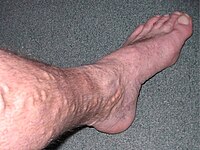
Photo from wikipedia
BACKGROUND Hypertonic saline (23.4%, HTS) bolus administration is common practice for refractory intracranial hypertension, but its effects on coagulation are unknown. We hypothesize that 23.4% HTS in whole blood results… Click to show full abstract
BACKGROUND Hypertonic saline (23.4%, HTS) bolus administration is common practice for refractory intracranial hypertension, but its effects on coagulation are unknown. We hypothesize that 23.4% HTS in whole blood results in progressive impairment of coagulation in vitro and in vivo in a murine model of traumatic brain injury (TBI). STUDY DESIGN For the in vitro study, whole blood was collected from 10 healthy volunteers, and citrated native thrombelastography (TEG) was performed with normal saline (0.9%, NS) and 23.4% HTS in serial dilutions (2.5%, 5%, 10%). For the in vivo experiment, we assessed the effects of 23.4% HTS bolus versus NS on serial TEGs and tail bleeding times in a TBI murine model (n=10 rats with TBI and 10 controls). RESULTS For the in vitro work, clinically relevant concentrations of HTS (2.5% dilution) shortened time to clot formation (R) and increased clot strength (maximum amplitude, MA) as compared to control and NS. With higher HTS dosing (5% and 10% blood dilution), there was progressive R prolongation, decreased angle and decreased MA. In the in vivo study, there was no significant difference in TEG measurements or tail bleeding times after bolus administration of 23.4% HTS compared to NS at 2.5% blood volume. CONCLUSION At clinically relevant dilutions of HTS, there is a paradoxical shortening of time to clot formation and increase in clot strength in vitro and no significant effects in a murine TBI model. However, with excess dilution, caution should be exercised when employing serial HTS boluses in TBI patients at risk for trauma induced coagulopathy.
Journal Title: Journal of the American College of Surgeons
Year Published: 2019
Link to full text (if available)
Share on Social Media: Sign Up to like & get
recommendations!